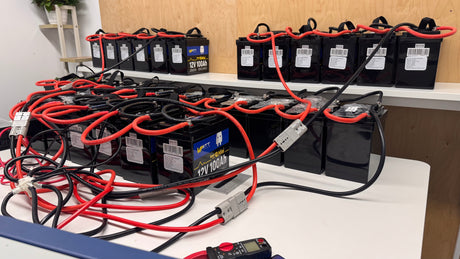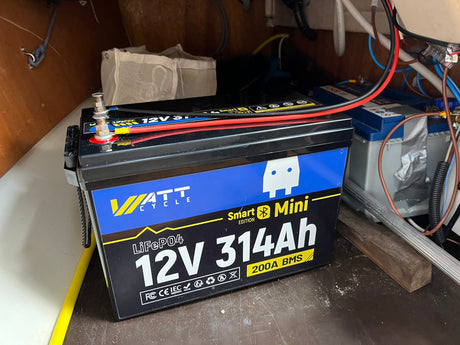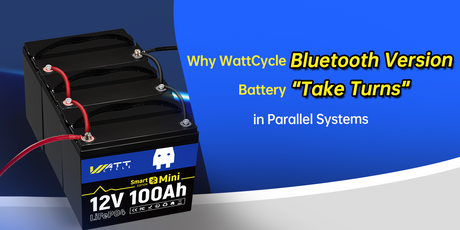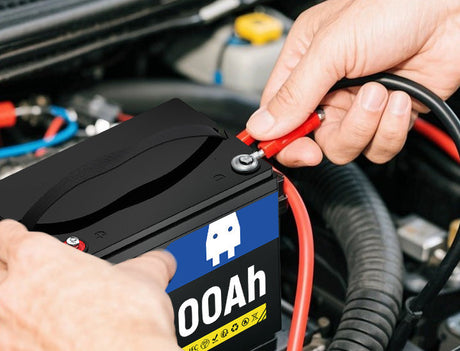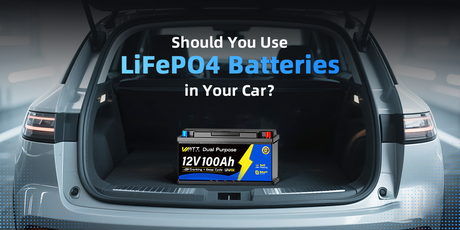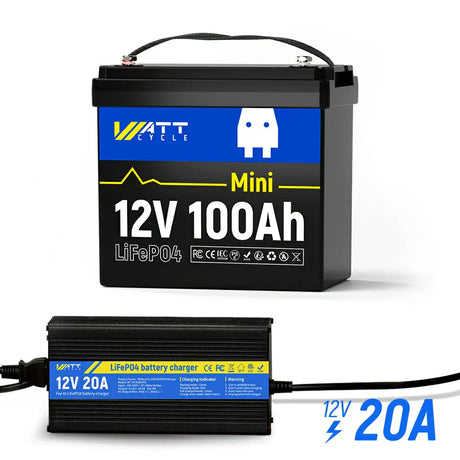Marine environments demand reliable, safe power solutions, and lithium iron phosphate (LiFePO4) batteries have quickly become the go-to choice for boaters seeking long run times and light weight. However, even the best deep cycle LiFePO4 cells can pose risks—thermal runaway, over-current events, and improper installation can lead to serious damage or injury.
Because of those risks, the marine industry needs rules tailored to lithium chemistries. ABYC E-13 is the American Boat and Yacht Council’s dedicated standard for onboard lithium battery systems. It defines clear expectations for cell and module construction, battery management, charging behavior, wiring, and installation practices so manufacturers, installers, and boat owners have a common, enforceable reference.
For boat owners and professionals alike, understanding ABYC E-13 is the first step toward safer, more reliable systems. When batteries and their associated equipment are designed and installed to E-13 principles, the likelihood of catastrophic failure is reduced and the overall dependability of the vessel’s electrical system improves—protecting people, craft, and gear.
ABYC & the E-13 Standard
The American Boat and Yacht Council (ABYC) is a nonprofit organization formed in 1954 to develop safety standards for recreational boats. Its technical committees bring together manufacturers, marine surveyors, electricians, and insurers to agree on practical guidelines that reduce risk on the water. As lithium ion battery use exploded in boating over the past decade, ABYC recognized the need for a dedicated standard, and in 2019 it released E-13 to address the unique properties of these chemistries.
E-13 standard in on lithium iron phosphate (LiFePO4) and similar lithium ion packs, setting out rules for everything from cell enclosure materials to wiring practices. Unlike lead-acid systems, lithium cells can undergo rapid thermal events and demand precise charge and discharge control. By prescribing construction methods, BMS requirements, and installation protocols, E-13 gives installers a clear road map to build and fit batteries that meet marine safety standard.
Scope & Applicability
Vessel types and use cases
ABYC E-13 applies across the full range of recreational craft where lithium ion batteries are installed—from small bass boats, pontoons and center-consoles to cruisers, sailboats and larger yachts. The standard is relevant whenever a lithium ion pack is used aboard, whether as a house bank that runs refrigeration and onboard systems, a starting or dual purpose battery that must deliver high crank currents and deep cycle performance, or a dedicated trolling motor battery supplying sustained thrust for fishing. In short, if the vessel relies on lithium chemistry for propulsion, starting, hotel loads or auxiliary systems, E-13 governs how that battery system should be installed and supported to manage risk and ensure dependable operation.
Interaction with other ABYC standards
E-13 does not operate in isolation. Installers must cross reference E-13 with other ABYC documents that govern related components and subsystems. For example, ABYC E-10 provides guidance on alternator charging and regulator settings, essential when configuring alternator charging profiles for LiFePO4 packs, and ABYC A-31 covers wiring, conductor sizing and over-current protection conventions that directly affect fuse and breaker selection for lithium systems. When planning an installation, follow E-13 for battery specific requirements while applying E-10, A-31 and any other applicable ABYC standards to alternators, charging sources, wiring runs and grounding to produce a coherent, code compliant system.
What E-13 Actually Is
Battery vs. installation standard
ABYC E-13 is an installation and safety standard for lithium ion battery systems aboard recreational vessels — it governs how a battery is installed, controlled, and supported on a boat, not how a battery must be designed or approved as a product. In practical terms, E-13 sets the requirements that installers, system designers, and boat owners must meet to reduce the risk of thermal events, electrical faults, and other hazards associated with lithium chemistries. ABYC is a member based organization that issues standards and guidance; it does not certify, approve, or endorse individual products or designs. Therefore, statements of compliance apply to installations performed in accordance with the current E-13 standard and the battery manufacturer’s supporting documentation.
Manufacturers play a critical supporting role: to enable an E-13 compliant installation they must supply accurate technical data (charge and temperature limits, BMS, wiring diagrams, torque specs, etc.). Installers remain responsible for following E-13 requirements and for documenting the installation so owners and insurers can verify compliance.
WattCycle, as a leading LiFePO4 battery manufacturer, structures its product design information and installation guidance to align with ABYC E-13 requirements. WattCycle provides the technical datasheets, BMS specifications, and installation instructions that installers need to perform E-13 aligned installations.
Core topics covered
E-13 addresses the safety and operational elements that together form a safe battery system. Key areas include:
- Cell & Module Construction—Requirements for acceptable lithium chemistries, cell quality/grade, mechanical protection, enclosure materials, and measures to limit propagation between cells or modules.
- Battery Management System (BMS)—Mandatory protections such as over-current interruption, over-charge and over-discharge limits, temperature cut-offs, cell balancing, and fault reporting/diagnostics. The BMS is the primary protective layer that must behave in predictable, documented ways.
- Charging Behavior—Specified charge profiles and limits (bulk/absorption/float where applicable), temperature-compensated charging, and compatibility rules for alternators, shore chargers, and solar controllers so that chargers do not drive the battery outside safe parameters.
- Wiring & Fusing—Conductor sizing, fuse or breaker placement (proximity to the battery positive terminal), connector and lug ratings, torque specification, and routing practices that reduce mechanical damage, corrosion, and short-circuit risk.
- Marking & Documentation—Durable labels, capacity and voltage markings, and comprehensive installation documentation (datasheets, wiring diagrams, BMS specifications, environmental limits, and maintenance instructions) that installers and owners must retain.
When a battery and its supporting information (datasheet, BMS spec sheet, wiring diagrams, and recommended charger/temperature limits) are provided and followed in the installation, the installer can reasonably state the system was installed in accordance with ABYC E-13.
WattCycle ABYC E-13 Products
12V 100Ah 1200CCA Dual Purpose Battery
WattCycle’s 12V 100Ah 1200CCA Dual Purpose Battery is engineered to support safe, code-aligned installations when fitted according to the current ABYC E-13 standard and WattCycle’s installation instructions. Key features that support E-13 installation practices include:
- 200A BMS protection: continuous 200A discharge limit with built-in over-current, over-temperature and short-circuit interventions that provide predictable, documented protective behaviour for installers.
- Self-heating capability: automatic heating below 0 °C (32 °F) with shut-off above 5 °C (41 °F), enabling reliable cold-weather starting while conforming to E-13 guidance on temperature-related protections.
- Forced-start button: an emergency start assist that helps with cranking demands while preserving BMS protections and installation safety.
- IP67 enclosure: dust- and water-resistant construction suitable for marine environments and consistent with E-13 expectations for durable mechanical protection.
- Bluetooth monitoring (WattCycle APP): real-time state-of-charge, voltage and fault reporting to aid commissioning, diagnostic checks and documentation required by installers.
- Supportive technical documentation: datasheets, BMS behaviour tables, charge/temperature limits, wiring diagrams and torque specs supplied to enable installers to meet E-13’s documentation requirements.
12V 100Ah LiFePO4 Battery TM (Trolling Motors)
The 12V 100Ah LiFePO4 Battery TM is tailored for trolling-motor and house-bank applications and provides the controls and information installers require to perform E-13-aligned installations. Notable attributes include:
120A continuous / 200A peak BMS: documented protections for over-current, over-charge, over-discharge and thermal events, with auto-recovery behaviour for defined fault conditions.
EV-grade LiFePO4 cells (15,000+ cycles): high-quality cells with long cycle life that reduce replacement and maintenance risks addressed in E-13 installations.
Low-temperature protection: automatic discharge cutoff below −4 °F and charge cutoff below 0 °C (32 °F), with resume thresholds above 5 °C (41 °F), matching E-13 expectations for temperature safety measures.
IP67 and vibration resistance: mechanical durability for marine use, supporting E-13 guidance on enclosure and mounting integrity.
Expandable system capability: clear guidance for series/parallel expansion (up to 4S4P) with supplied balancing and BMS notes to help installers design compliant multi-battery systems.
Comprehensive installation materials: full datasheet, BMS specification, wiring diagrams, charge limits and commissioning instructions provided to support E-13-required documentation and installer verification.
Permissible installation statement
When installed per the current ABYC E-13 standard and WattCycle’s supplied instructions, WattCycle 12V 100Ah LiFePO4 battery TM and 12V 100Ah dual purpose battery provides the documented features and controls necessary for an installer to state the installation meets ABYC E-13 installation requirements.
Conclusion
ABYC E-13 exists to make lithium ion battery installations on recreational vessels safer and more predictable. It is an installation and system-level standard, not a product approval. What matters to owners and installers is that the battery, its BMS, and the supporting documentation allow an installation to be performed in accordance with the current E-13 requirements.
WattCycle designs its LiFePO4 products and technical documentation to support E-13 aligned installations. Our guidance, datasheets, BMS specifications, wiring diagrams and charge/temperature limits, everything is done with your safety and comfort in mind. For the battery itself, the battery development standards of WattCycle are even higher than those of ABYC.
Next steps
Download the full datasheets and installation guides for the 12V 100Ah 1200CCA Dual Purpose Battery and the 12V 100Ah 100Ah LiFePO4 Battery TM from the WattCycle product pages to review charge limits, BMS behavior and wiring diagrams.
Contact WattCycle technical support or your local WattCycle dealer for commissioning assistance, recommended charger settings, or guidance on series/parallel configurations.
If you’d like, WattCycle can provide installer ready wiring diagrams and suggested commissioning checklists to help ensure your installation aligns with ABYC E-13 expectations.


![[Buying Guide] WattCycle Battery Black Friday Deals 2025](http://www.wattcycle.com/cdn/shop/articles/WT_1x_d33466eb-bde0-4f65-9e5c-6034e6ac3957.webp?v=1762940680&width=460)
